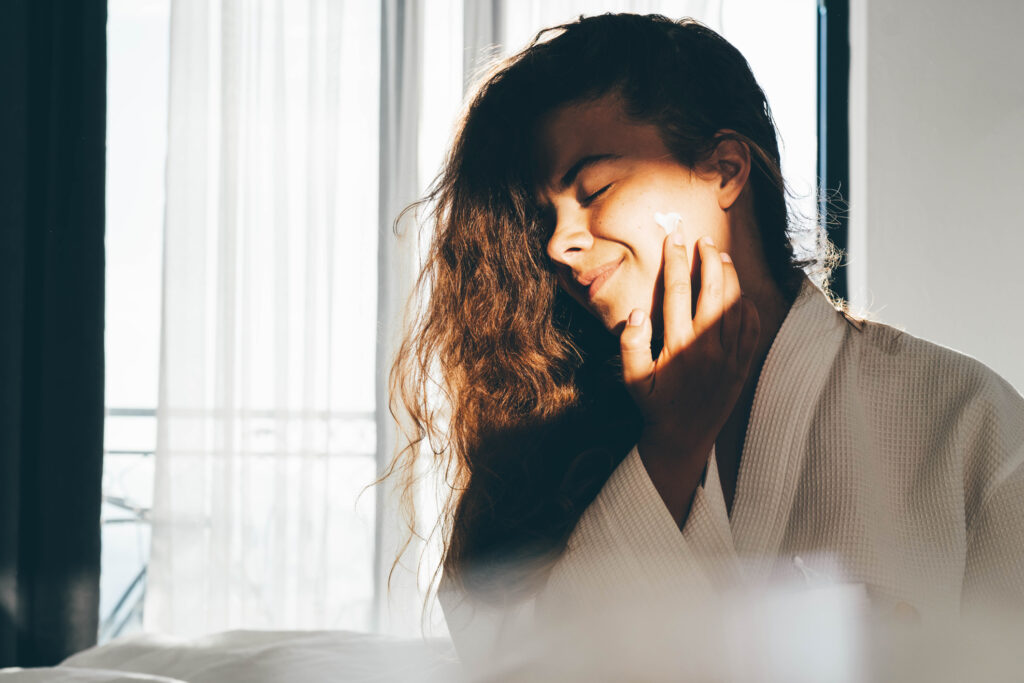Photosensitivity & Your Skin
What It Is. How It Affects You. What You Can Do.
No matter your skin type, if you develop photosensitivity, you may be especially at risk for lasting skin damage and skin cancer from even limited exposure to ultraviolet (UV) radiation.
Understanding what photosensitivity is and why it occurs will help you take extra care to safeguard your skin health.
Not everyone develops photosensitivity. But, if you have a higher risk, your best option is to take steps to prevent a sun-sensitive reaction from happening at all.
What is photosensitivity?
Photosensitivity is heightened skin sensitivity or an unusual reaction when your skin is exposed to UV radiation from sunlight or a tanning bed. You can become photosensitive as a result of prescription or over-the-counter medications, a medical condition or genetic disorder, or even by using certain types of skin care products. There are two distinct types of photosensitivity reactions: photoallergic and phototoxic.
Phototoxic reaction
This is the most common reaction and usually occurs when a drug you’re taking (whether by mouth or topically applied) is activated by exposure to UV light and causes damage to the skin that can look and feel like a sunburn or a rash. This can also be triggered by certain ingredients in skin care products. A phototoxic reaction can happen within minutes or after hours of exposure and is usually limited to the skin that has been exposed.
Photoallergic reaction
This response is far less common and occurs when UV rays interact with the ingredients in medicines or other products applied directly to the skin. The body’s immune system recognizes changes caused by sun exposure as a foreign threat. The body produces antibodies and attacks, causing a reaction. A photoallergic reaction can leave you with a rash, blisters, red bumps or even oozing lesions one to three days after application and exposure to the sun.
What causes photosensitivity?
You can become photosensitive from:
- Medications: Some widely used medications, including antibiotics, nonsteroidal anti-inflammatory drugs (NSAIDS), antihistamines and certain heart medicines and statins for lowering cholesterol, can make you far more sensitive to sunlight than you’d usually be. Sun-sensitizing drugs can also aggravate existing skin conditions. Check this detailed list of medications that have been connected with photosensitivity reactions.
- Diseases and medical conditions: Certain medical conditions and disorders, including autoimmune diseases like lupus, can make you hypersensitive to UV rays. Check our report to see a list of diseases and conditions that can cause photosensitivity.
- Skin-care products: Certain ingredients in products you use to make your skin look better, such as retinols, glycolic acid or benzoyl peroxide, remove the outermost layer of skin to fight fine lines or acne. Brighteners like vitamin C may decrease the melanin in your skin, which acts as a natural defense against the sun’s rays. These may cause photosensitivity and increase your chances of damage from UV exposure. Being diligent about sun protection is crucial while using these products.
Why does it matter?
Photosensitivity reduces your natural defenses and elevates your risk for damage from the sun’s harmful rays. If you have a photosensitivity reaction due to medications or a medical condition, it can also potentially increase your risk of developing skin cancer.
What you can do
To gain a better understanding about photosensitivity and your skin:
- Ask your doctor about risks associated with any medicines you take or medical conditions you may have and how long any potential photosensitivity might last.
- Ask your dermatologist about the risks of sun sensitivity from any skin-care products you are using for antiaging, skin brightening or acne, whether prescription or over-the-counter.
- Read the warning labels and package inserts for your medications, skin-care products and supplements to understand your risks.
If you have a reaction
- How do I treat a sunburn-like photosensitive reaction?
You can treat this type of photosensitivity reaction similar to the way you would treat a sunburn. - When should I see a doctor?
See your physician if you develop flu-like symptoms, including fever with chills, nausea, headache and weakness, or if your skin blisters. A blistering sunburn is considered a second degree burn of the skin. This will require medical treatment beyond over-the-counter treatments. - How do I know if my photosensitive reaction is drug-induced?
If a medication is the suspected cause, diagnostic tests, including phototesting, photopatch testing and clinical rechallenge can be completed to determine if the burn was secondary to a photosensitive reaction. Once a diagnosis of a drug-induced photosensitivity is made and the medication that caused it is identified, the medication may be discontinued, if possible.
Sun protection basics
- Minimize your exposure to UV radiation from the sun, especially during the peak hours of 10 AM to 4 PM, and avoid indoor tanning. Shade is your friend!
- Take extra care to shield yourself from the sun. Wear a broad-brimmed hat and sun-protective clothing. Use a broad-spectrum sunscreen with an SPF of at least 30 on all exposed skin. Don’t forget the backs of your hands and reapply sunscreen every two hours. Find sunscreen products with our Seal of Recommendation.
- Understand how to safeguard your skin: Your Daily Sun Protection Guide.
- Check your skin monthly and visit a dermatologist at least once a year for a professional skin exam.
Safeguard against skin cancer
Understanding photosensitivity is one step in a comprehensive approach to skin health. Be sure you understand all your skin cancer risk factors and protect yourself, each and every day.
Reviewed by:
Navin Arora, MD



